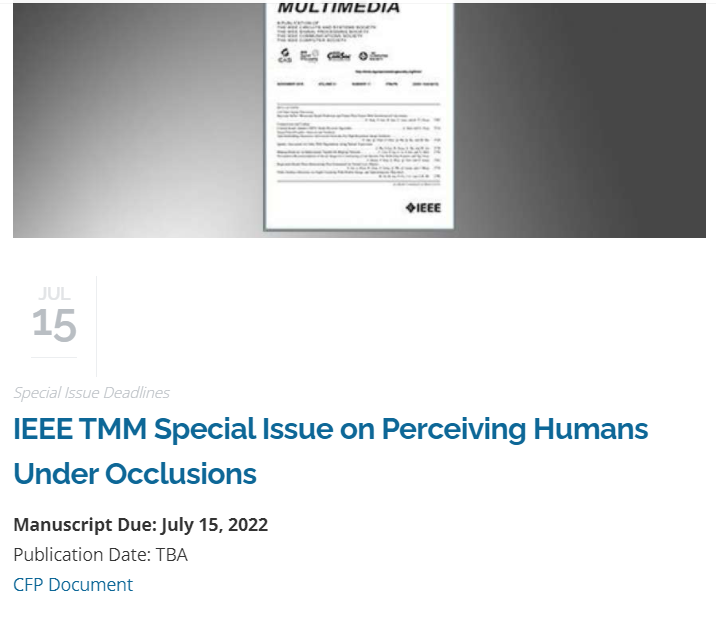祝贺:遮挡行人感知专刊(Special Issue on Perceiving Humans Under Occlusions) 在IEEE TMM 期刊上成功获批

n Motivations and Topics:
Humans are the most frequent and important participants in our daily visual data. Therefore, it is of great interest to capture, perceive and understand humans via computer vision techniques. These techniques can be widely used in various applications, e.g. autonomous driving, video surveillance, robotics, etc.
We notice a major challenge in this area is occlusion, which happens frequently in practice, especially on edge devices, such as surveillance cameras. For example, with the spread of Covid-19, humans usually wear masks in public places, which largely affects the performance of face detection and recognition; in the traffic scenario, pedestrians can be occluded by other objects or nearby pedestrians; in public places, people may gather in crowds, leading to high overlaps with each other. In recent years, occlusion handling for humans has attracted much attention, for instance, several partial person re-identification datasets and occluded pedestrian datasets have been proposed, and a few methods based on attention have been proposed to address this problem. Unfortunately, the performance of current methods are still far from satisfactory especially under severe occlusions, especially on low-resolution edge cameras. Therefore, we are highly motivated to investigate more robust methods against occlusions, so as to better perceive humans in visual data.
To the best of our knowledge, few special issues focus on occlusion handling for perceiving humans. Therefore, the special issue is proposed to encourage original research on more robust methods against occlusions. These methods are expected to push forward the applications of various vision tasks for perceiving humans in real-world scenarios.
This special issue serves as a forum for researchers all over the world to share their works and recent advances in the field of Perceiving Humans Under Occlusions. It is expected to promote the development of occlusion handling technologies for a wider range of human oriented computer vision tasks.
The special issue seeks original contributions which address the challenges in perceiving humans under occlusions. Articles with novel ideas, datasets, and comprehensive literature reviews, are all welcome for submission. Related topics include but are not limited to:
o Edge face detection and recognition with partial occlusions;
o Federated face detection and recognition with partial occlusions;
o Occluded and partial person re-identification;
o Federated person re-identification/detection with partial occlusions;
o Occluded person detection on edge devices;
o 2D/3D Human parsing/pose estimation at crowds;
o 3D human body modeling under occlusions;
o Gesture recognition under occlusions;
o Gait recognition under occlusions;
o Emotion recognition with partial occlusions;
o Federated crowd counting;
o Multi-modal fusion for occlusion handling;
o Data augmentation for occlusion handling;
o Feature enhancement for occluded human body;
o New occlusion oriented image/video datasets and benchmarks with humans.
n The Proposed Schedule is given below:
· Paper submission due: July 15, 2022
· First review notification: September 15, 2022
· Revision submission: October 15, 2022
· Second review notification: November 15, 2022
· Acceptance notification: December. 15, 2022
n Guest Editors:
Prof. Dr. Jun Wu, Fudan University, China
(wujun@fudan.edu.cn )
Prof. Dr. Cairong Zhao, Tongji University, China
(zhaocairong@tongji.edu.cn )
Prof. Dr. Roger Zimmermann, National University of Singapore, Singapore
(dcsrz@nus.edu.sg)
Prof. Dr. Wei-Shi Zheng, SUN YAT-SEN University, China
(zhwshi@mail.sysu.edu.cn)
Prof. Dr. Shanshan Zhang, Nanjing University of Science and Technology, China
(shanshan.zhang@njust.edu.cn)
Prof. Dr. Jürgen Gall, University of Bonn, Germany
(gall@iai.uni-bonn.de)
